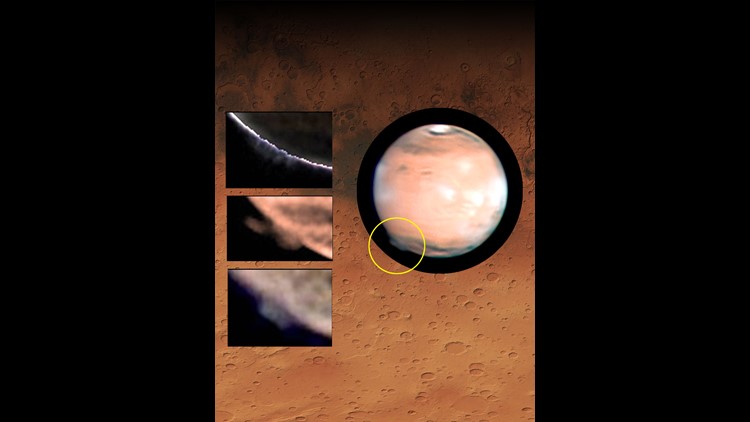(USA Today) -- Amateur astronomers have spotted huge cloudlike plumes erupting from Mars – a phenomenon that scientists are at a loss to explain.
The bright flares, which have now died away, towered higher than anything else observed in the Martian atmosphere. Their tops reached some 150 miles in altitude, more than twice as high as the highest Martian clouds, and they sprawled across 300 to 600 miles, researchers report in this week's Nature, a science journal.
The researchers initially were skeptical, but "we came to the conclusion that what we were seeing is actually real," says study co-author Antonio García Muñoz, a planetary scientist at the European Space Agency. The plumes are "exceptional. … It's difficult to come to terms with this."
This scientific brainteaser first came to light in early 2012, when amateur astronomer Wayne Jaeschke was poring over footage of Mars he had captured at his private observatory. He came across a puzzling image showing the Red Planet with a blob of something billowing off the planet's rounded edge.
In all his years of peering at Mars, "I'd never seen anything like that," says Jaeschke, a West Chester, Pa., resident who spends about 100 nights a year training his gear on the heavens. He quietly ran the image by a few friends, then circulated it among a larger group of both amateur and professional astronomers.
The image confounded the pros, too. Martian clouds, which are typically made of ice crystals, tend to be wispy, like the thin cirrus clouds seen high in Earth's sky. But these were enormous wide plumes seen on 11 days in March 2012 and again in April 2012. Later, the scientists dug up 1997 images of Mars from the Hubble Space Telescope that show a similar plume.
Best space photos from 2014:
Perhaps the bright fingers are clouds of ice crystals. But for that to be true, the Martian atmosphere would have to be much colder than expected, the scientists concluded. Perhaps the plumes are a particularly dazzling Martian aurora, like the Northern Lights on Earth. If so, they were 1,000 times stronger than any aurora ever seen on Earth. Further, there's no record of unusual sun activity – an essential ingredient of a spectacular aurora – on the days when the shiny bulges appeared on the planet's profile.
Other scientists, however, are reacting with caution to the claims.
Planetary scientist Nicholas Heavens says the Hubble image adds credibility to the claims of something new and strange in the atmosphere of Mars. But he's still not totally convinced there hasn't been some kind of mistake.
"It's a pretty good argument, but there's a hole or two in it," says Heavens, of Hampton University in Hampton, Va.
Planetary scientist Todd Clancy of the Space Science Institute is more blunt.
"I don't think it's real. … Basic physics says this can't occur," Clancy says, adding that the conditions in Mars's upper atmosphere don't supply the necessary ingredients for clouds.
In response, study co-author Agustin Sánchez-Lavega, a planetary scientist and physics professor at the University of the Basque Country in Spain, notes that 19 different observers captured the strange eruptions. He considers the source of the formations "open to discussion," he says via e-mail.
As an amateur, Jaeschke is happy to let the academics argue over what exactly he saw.
Amateurs "only dabble," he says, so it's "exciting … (to) have seen something that stumped the professionals."



